The heat transfer characteristics and performance of the flat plat collector with and without porous media are studied. An experimental study was conducted to evaluate the thermal performance of a flat plate collector by using a packed bed of Sand, Black stone. This is acted as a heat storage material. The solar energy was stored in the packed bed through the high solar intensity period and extracts at low intensity. The experimentally obtained results are used to analyze the performance of the system based on temperature distribution in different localization of the absorber. The thermal performance evaluation of the flat plat collector with and without porous medium has been analyzed experimentally and the results of both medium are compared. The perfect and efficient heat storage material is developed.
INTRODUCTION |
| Energy is a vital need in all aspects and due to the increasing demand for energy coupled with its in efficient
consumption, the environment has been polluted either directly or indirectly. To prevent this from becoming a global
disaster, it is inevitable to strengthen efforts of energy generation and utilization using sustainable means and
progressively substituting the fossil fuels for renewable sources of energy. The solar radiation level in Malaysia is high,
ranging from 6.6kWh/m2 in January to 6.0kWh/m2 in August, which is ideal for several solar energy applications
(Mohd et al., 1999). |
| Extensive investigations have been carried out on the optimum design of conventional and modified solar air heaters, in
order to search for efficient and inexpensive designs suitable for mass production for different practical applications.
The researchers have given their attention to the effects of design and operational parameters, type of flow passes,
number of glazing and type of absorber flat, corrugated or finned, on the thermal performance of solar air heaters
(Ratna et al., 1991; Ratna et al., 1992; Choudhury et al., 1995; Karim and Hawlader, 2004). Ratna et al. (1991) has
presented theoretical parametric analysis of a corrugated solar air heater with and without cover, where they obtained
the optimum flow channel depth, for maximum heat at lowest collector cost. Ratna et al. (1992) has found that there
exists an optimum mass flow rate corresponding to an optimum flow channel depth. This result has been concluded
after conducting a study on 10 different designs of solar air heaters. Choudhury et al. (1995) has calculated the ratio of
the annual cost and the annual energy gain for two- pass solar air heaters with single and double covers above the
absorber. |
| They concluded that for short- er duct lengths and lower air mass flow rates, the performance of the two pass air heaters
with a single cover is most cost effective as compared to the other designs. Karim and Hawlader (2004) have performed
an experimental study on three types of solar air collectors, i.e. flat plate, finned and corrugated absorbers. They
reported that the V-corrugated is the most efficient collector and the flat plate collector is the least efficient. In spite of
this concern on improving the performance of solar air heaters, little has been published on the effect of the air flow
passage dimension on the efficiency and pressure drop and hence the cost-effectiveness of the system. Bashria et al.,
(2004a) and Bashria et al., (2004b) presented a developed internet based mathematical simulation to predict the thermal
performance for different designs of solar air heaters. The study presented in this article uses the afore- mentioned
developed program to find the influence of different parameters, such as mass flow rate, flow channel depth and collector length on the system thermal performance and pressure drop across the collector, for flat plate collector in
single and double passes with and without using a porous media. |
| It is observed that in many fluid heating applications, it is desirable to have options for simultaneous heating of air and
water streams. A dual purpose solar collector is a novel solar energy conversion device which can be used for
simultaneous heating of water and air streams. The system essentially relies on a basic flat plate collector with
appropriate design changes to accomplish these tasks. Adequate heat delivery and optimization of space are possible
with this type of integrated system. |
| Dual purpose solar collectors have the potential to find applications in diverse areas like building air and water heating,
process heating applications etc. Assari et al had presented basic theoretical and experimental investigations on dual
purpose solar collector. |
| The focus of the present work is on the performance enhancement of a dual purpose solar collector integrated with a
porous matrix. Numerical simulations of the modified system are undertaken to suggest the design improvements for
the system. With the help of illustrative examples, the proposed system is compared with existing design of a dual
purpose solar collector. |
EXPERIMENTAL SETUP |
| A flat plate collector consists of an outer and inner case which is made up of steel. In between the two cases there will
be an insulating material made up of wool which will keep the heat without dissipating to the outside of the flat plate
collector. In the inner case a copper plate is placed and it is used to absorb the heat. There will be an air gap below and
above the copper plate in order to hate the incoming air. A glass plate is fixed on the outer case so that it will cover the
entire setup. This glass will penetrate the UV rays from the sun to the copper plate. |
| During the day time the heat from the sun will be fall on the glass plate and this plate will allow the UV rays to fall on
the copper plate. This made the copper plate to get heated. The copper plate is naturally a good heat absorbing material.
The air gap provides the flow of air around the copper plate and thus this plate will heats the air. |
| Heated air can be used directly in air heating systems without the need for external fluid loop. Corrosion problems are
considerably reduced. Solar air heaters could be used for a wide variety of industrial applications such as crop drying,
adsorbent beds regeneration in separation processes and meeting buildings heating load. Freezing and boiling problems
are also eliminated. |
| The major heat losses from flat-plate solar collectors are through the top cover so that the sides and the bottom of the
collector can be well insulated. The insulators can reduce the collector top heat losses due to its low thermal
conductivity; however it is characterized also with lower transmittivity compared with glass. Therefore, the transmitted
part of the solar radiation to the air inside the solar collector is lower. |
SOLAR FLAT PLAT COLLECTOR DIMENSIONS |
| Area =2000mm*1000mm |
| Copper absorber plat thickness =0.8 mm |
| Outer case =2050mm*1050 mm |
| Inner case =2000mm*1000 mm |
| A-type glass =2050mm*1050 mm |
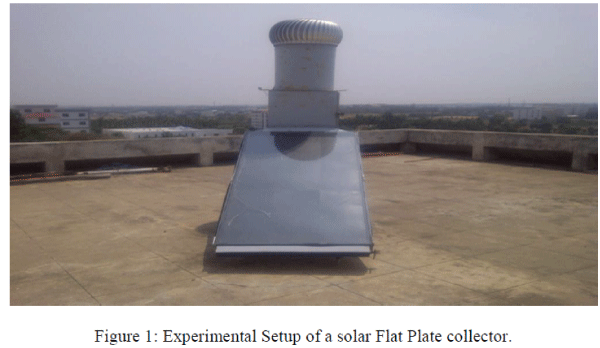 |
THEORETICAL ANALYSIS |
| In all types, the air heaters are composed of three plates, i.e. the cover, the absorber and the rear or back plate. The air
flows in the upper channel depth between the cover and the absorber plate in Single flow, but it is turned to continue
flowing in the lower duct between the absorber and the rear plate in Double flow. The lower duct has been packed with
sand as a porous medium. The following analysis is based on energy balance at various components of the collector
models, along with the different heat transfer coefficients at their surfaces. The assumptions made are: |
| Heat transfer is steady and one dimensional |
| The temperatures of the glass, absorber and bottom plates vary only along the x-direction of the air flow |
| There is no leakage from the smooth flow channels the absorption of solar radiation in the cover is neglected insofar as
it affects loss from the collector |
| Heat losses through the front and back of collector are to the same ambient temperature At some location along the
flow direction, the absorbed solar energy heats up the plate to a temperature. |
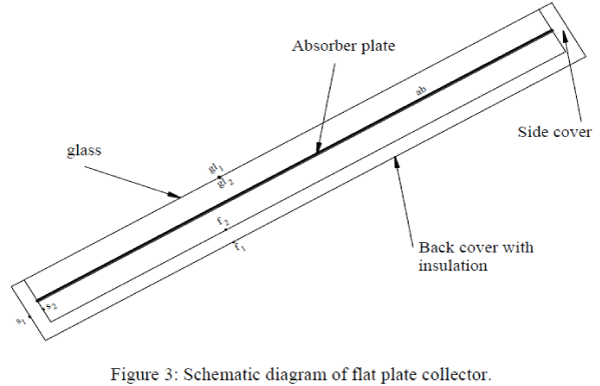 |
THERMAL ANALYSIS OF FLAT PLATE COLLECTOR |
| The 3D modeling of flat plate collector is designed using Solid Works software. All the drawing dimensions are in mm
and it is saved in IGES format and it can be imported to ANSYS to perform Thermal analysis. |
| 5.1 Input parameters: |
| Initial temperature = 33°C. |
| Emissivity = 0.92. |
| Radiation = 968 W/m2. |
| 5.2 3D View of flat plate collector: |
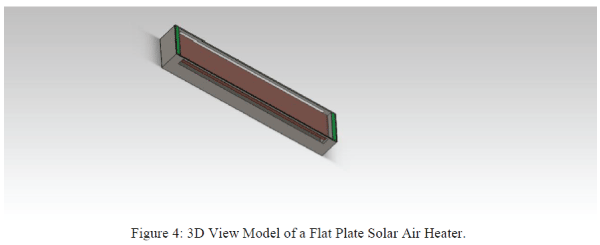 |
5.3 Thermal analysis using ANSYS: |
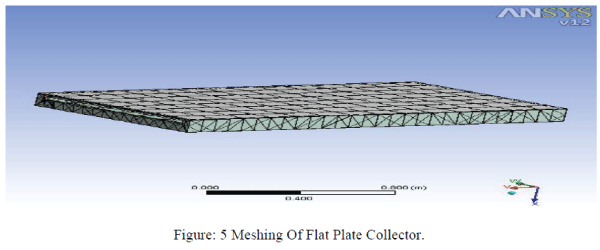 |
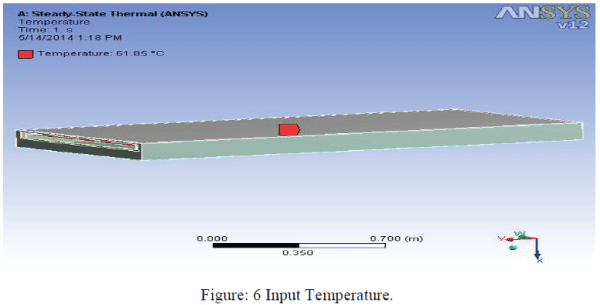 |
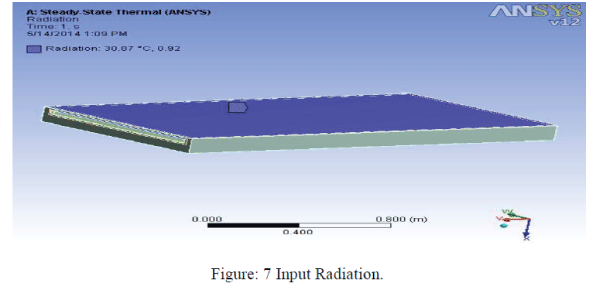 |
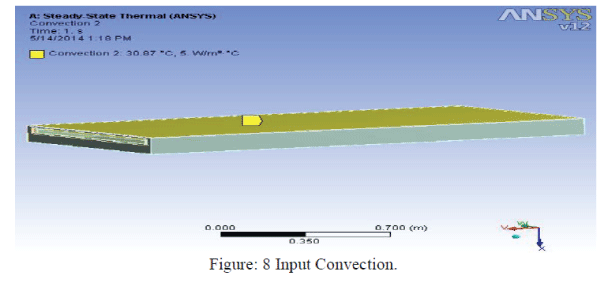 |
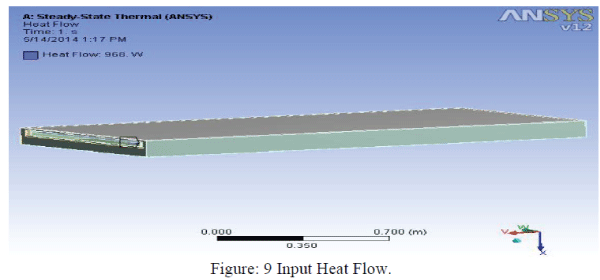 |
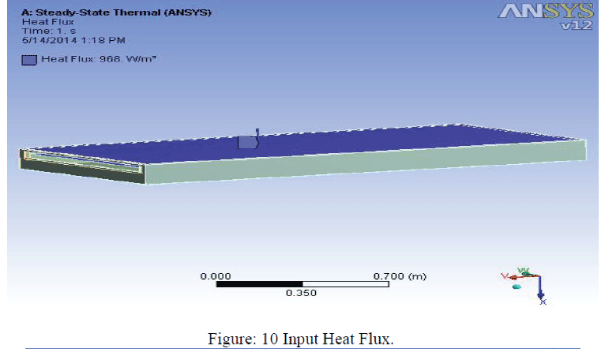 |
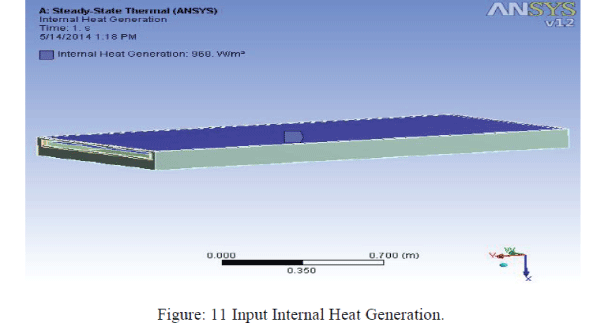 |
5.4 Resultant Diagram of Thermal Analysis: |
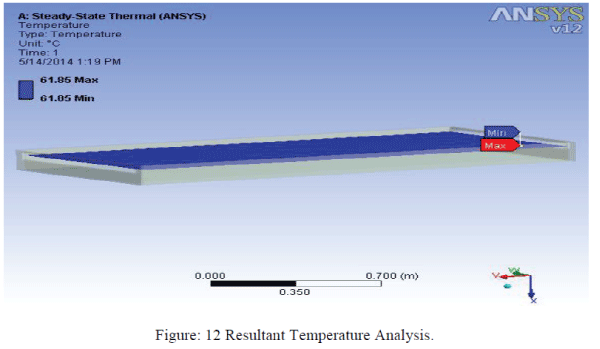 |
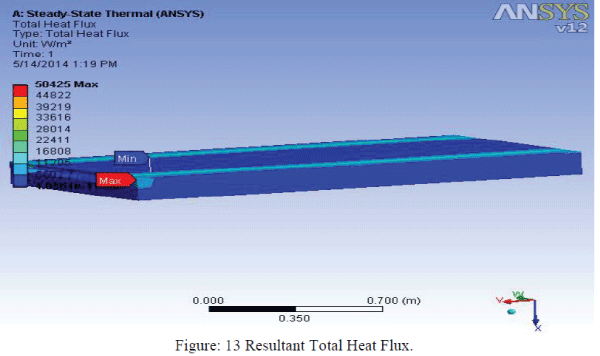 |
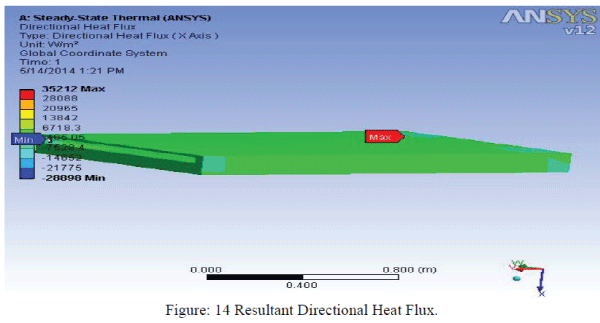 |
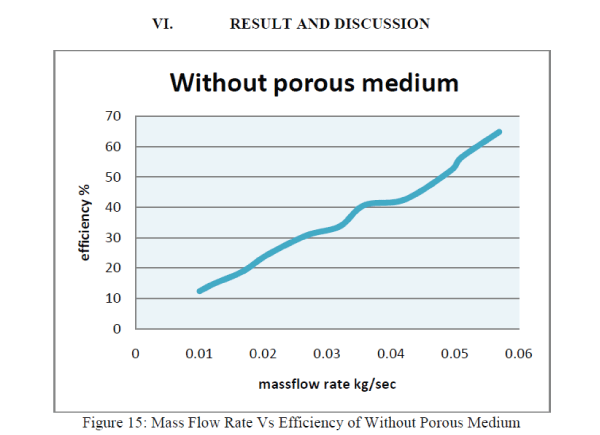 |
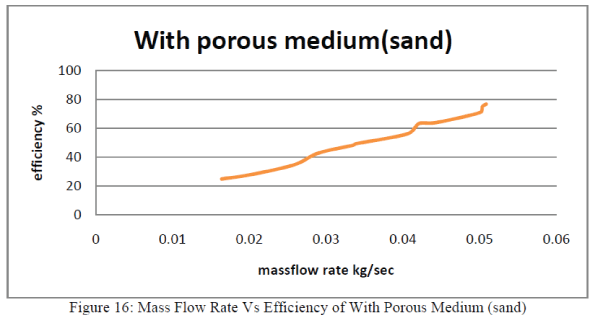 |
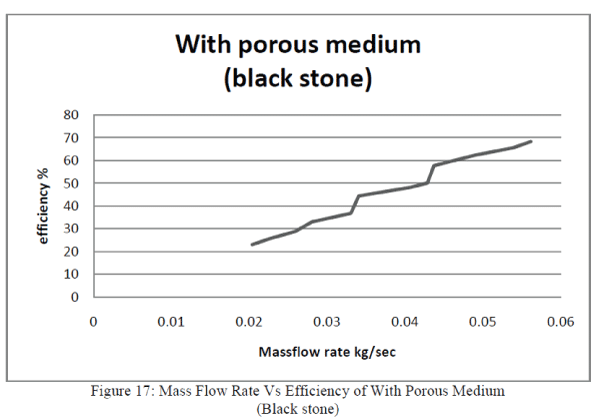 |
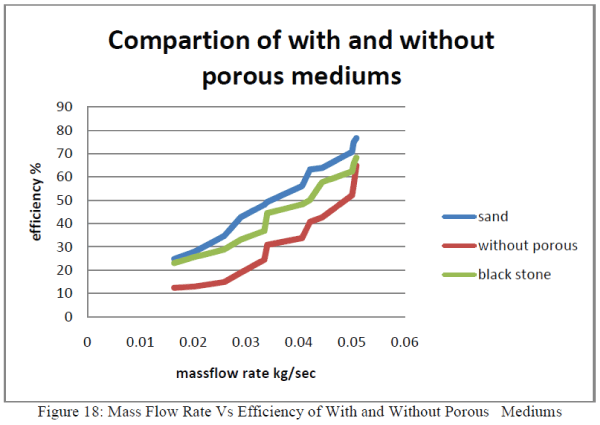 |
| An Experimental analysis is done to predict the effect of different parameter thermal performance and pressure drop,
for smooth plate double pass solar air heater with and without using a porous media. |
| It is found that thermal efficiency greatly based on mass flow rate it increase with increase mass flow rate but it also
increase the pressure drop. The double flow is more efficient than the single flow made and using of porous media
increase the system efficiency and the outlet temperature. From the graph, the efficiency of the porous medium will be
maximum than the without porous medium. The efficiency will be get up to 77%. Moreover, the efficiency is
maximum with the use of sand as porous medium while compared to the black stone. It was generally observed that the
efficiency increased with the increase mass flow rate of air. The methods of conducting the porous experiment for both
porous and non porous media were always same. The outlet temperature obtains for sand is more efficient than the
black stone. Sand is more efficient than the non porous media. The efficiency increased about 80% at same conditions
when sand was used as porous media. |
CONCLUSIONS |
| The experimental results to predict the effect of different parameters on system thermal performance and efficiency, for
flat plate collector in double flow mode with and without using a porous media have been conducted. It is found that
increasing the mass flow rate through the air heaters results in higher efficiency. The double flow is more efficient than
the single flow mode due to the increased heat removal for two channels compared to one flow channel, and the using
of porous media increase the system efficiency and the outlet temperature hence the use of porous media increases the
heat transfer area. |
| This increment will result in the increase of the pressure drop thus increasing the pumping power expanded in the
collector. Thermal performance of the collector is improved by integrating a porous matrix in the absorber plate of the
system. Thus, finally concluded that the efficiency will be maximum only by using the sand as a porous medium. Also,
this will be economic when compared to non porous medium of the solar flat plate collector. |
References |
- BAA Yousef NM Adam “Performance analysis for flat plate collector with and without porous media” Alternative and Renewable EnergyLaboratory, Institute of Advanced Technology, University Putra Malaysia, Serdang, Malaysia.
- BhupendraGuptaȦ*, Gopal Prasad ManikpuriȦ, Experimental Investigation of Double Pass Solar Air Heater using different type o f PorousMedia.
- S. Chemkhi, F. Zagrouba, and A. Bellagi, "Drying of agricultural crops by solar energy, "Desalination, vol. 168, pp. 101-109, 2004.
- Ion V. IONa, Jorge G. MARTINS “Design, developing and testing of a solar air collector” 2006.
- B. A. A. Yousef and N. M. Adam “Thermal Performance and Economic Effectiveness for Solar Air Heaters: Analysis and Expert SystemDevelopments”
- Department of Mechanical and Manufacturing Engineering, Faculty of Engineering Universiti Putra Malaysia, 43400 UPM Serdang, Selangor,Malaysia
- (Received on 3 Oct 2005, revised on 30 Jan 2006).
- Mohamad, A.A., 1997. “High efficiency solar air heater”. Solar Energy 60 (2), 71–76.
- Swartman, R.K., Ogunade, O., 1966. “An investigation of packed bed collectors”. Solar Energy 10, 106–110.
- Mridul Sharma, Varun, “Performance estimation of artificially roughened solar air heater duct provided with continuous ribs” Department ofMechanical Engineering, National Institute of Technology, Hamirpur, 177005, India, 2010.
- Y. H. Mohd, Y. Baharudin, and W. R. W. Daud, “Concept model of A 100 kWP PV village in Malaysia,” Commercialization of MalaysianR&D, KementeriamSams, Teknologi dam AlamSekitar. (1), 1996, pp. 206- 211.
- K. Sopian, Supranto, W. R. W. Daud, M. Y. Othman and B. Yatim, “Design of a solar assisted drying system using the double pass solarcollector,” In Proc., World renewable energy congress, Malaysia, 1999, pp. 89-93.
- Kolb, A., Winter, E.R.F., Viskanta, R., 1999.”Experimental studies on a solar air collector with metal matrix absorber”. Solar Energy 65 (2),91–98.
- Ion V.I., Martins G.J., “Performance investigation of a solar air collector”, 2009.
- Choundhury, C., Anderson, S.L., Rekstand, J., 1988. “A solar air heater for low temperature application”. Solar Energy 40, 335–344.
- Garg, H.P., Choundhury, C., Datta, G., 1991.”Theoretical analysis of a new finned type solar collector”. Energy 16, 1231–1238.
- Han J.C., Zhang Y.M. High performance heat transfer ducts with parallel, broken and V-shaped broken ribs. International J. of Heat and MassTransfer. 1992, 35(2), 513-523.
- Gupta D., Solanki S.C., Saini J.S. Thermohydraulic performance of solar air heaters with roughened absorber plates. Solar Energy. 1997, 61(1),33-42.
- Saini S.K., Saini R.P. Development of correlations for Nusselt number and friction factor for solar air heater with roughened duct having arcshapedwire as artificial roughness. Solar Energy. 2008, 82(12), 1118-1130.
- Verma S.K., Prasad B.N. Investigation for the optimal thermohydraulic performance of artificially roughened solar air heaters. RenewableEnergy. 2000, 20(1), 19-36.
- Jaurker A.R., Saini J.S., Gandhi B.K. Heat transfer coefficient and friction characteristics of rectangular solar air heater duct using rib-groovedartificial roughness. Solar Energy. 2006, 80(8), 895-907.
- Varun, Saini R.P., Singal S.K. Investigation of thermal performance of solar air heater having roughness elements as a combination of inclinedand transverse ribs on the absorber plate. Renewable Energy. 2008, 33(6), 1398-1405.
- Prasad K., Mullick S.C. Heat transfer characteristics of a solar air heater used for drying purpose. Applied Energy. 1985, 12(2), 83-93.
- Prasad B., Saini J.S. Effect of artificial roughness on heat transfer and friction factor in a solar air heater. Solar Energy. 1988, 41(6), 555-560.
- Bhagoria J.L., Saini J.S., Solanki S.C. Heat transfer coefficient and friction factor correlations for rectangular solar air heater duct havingtransverse wedge shaped rib roughness on the absorber plate. Renewable Energy. 2002, 25(3), 341-369.
- Mohamad, A.A., 1997. High efficiency solar air heater. Solar Energy 60 (2), 71–76.
- Henden, L., Rekstad, J., Meir, M., 2002. Thermal performance of combined solar systems with different collector efficiencies. Solar Energy 72(4), 299–305.
|